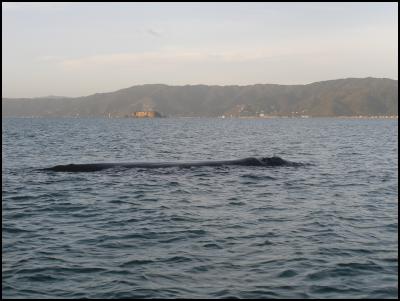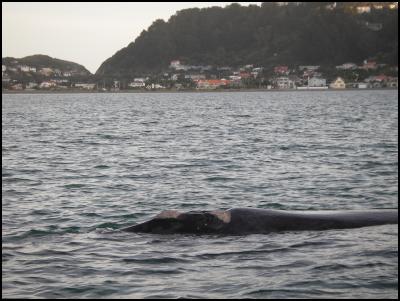Help sought to track southern right whales
Help sought to track southern right whales

Click to enlarge
Southern right whale, In front of Makaro/Ward Island Photo: Andrew Morrison/DOC.

Click to enlarge
Southern right whale, In front of Seatoun beach Photo: Peter Simpson/DOC.
29 May 2007
Help
sought to track southern right whales
The appearance of a southern right whale in Wellington Harbour yesterday has coincided with a call for public support to help track their whereabouts.
It is also a timely reminder that southern right whales may soon be visible from the coast throughout New Zealand.
For the fourth year running, the Department of Conservation is calling on the public to report sightings of southern right whales (tohora)
“The purpose of the research is to clarify the relationship between the whales we see around the mainland and those that are known from the New Zealand subantarctic,” reports DOC marine conservation officer Steve Smith.
“I was about to alert marine specialists and the public to the possibility of sighting whales around mainland New Zealand, when one of them made a spectacular public appearance around Wellington’s inner harbour beaches.”
“Southern right whales spend a large portion of their winter breeding months (June – September) very close to the shore in sheltered waters, sometimes resting on the bottom with their blowholes above the surface. This is exciting as it provides a rare opportunity for members of the public to see large whales from the coast”.
These slow travelling, coastal whales were so abundant in New Zealand waters that early settlers in Wellington complained that the noise of their blowing kept them awake at night! Though by 1936, when they were protected, they were on the verge of extinction.
Mr Smith said it was possible that the whales around the mainland are geographically isolated from those that breed further south. To date no movements between these areas has been documented.
“If the mainland whales do represent a smaller separate population we need to know about it so we can take special measures to see that these whales are afforded a high level of protection from any potential impacts, such as marine farms, ship strikes and coastal development.”
In the last four years around15 individual genetic samples have been obtained from southern right whales around New Zealand, largely thanks to tip-offs from the public.
“And we’ve received a lot of good quality photographs for individual identification as well,” Mr Smith said.
“These observations have increased our knowledge of this rare and threatened marine mammal, but to ensure a secure future for these whales we would do well to obtain even more clarity on this issue.”
The Department of Conservation would like to stress the importance of the vital part that the public plays in ensuring the continued success of this programme.
Southern right whale sightings should be reported to DOC, preferably as soon as possible after the sighting is made, on 0800 DOCHOT line (0800 36 24 68). DOC needs to know the date, time and location of the sighting; the number of whales; whether there were any calves; and their direction of travel.
Photos help identify individual whales, especially those of the left side of the head, and of the full body length.
Adults are on average 14.5m long, and newborn calves, between 4.5m and 6m. They are mostly black in colour and can be identified by their lack of a dorsal fin, a V-shaped blowhole spray, and white growths on their heads called callosities. Each whale has a unique callosity pattern.
Whales should be approached slowly, quietly and cautiously, and no closer than 50m, preferably from behind or parallel to them. Boaties are requested not to obstruct their path, cut through a group or separate mothers from calves, and to cut their engines if a whale approaches their vessel. Making sudden noises may startle the animals and should be avoided. Aircraft should keep a 150m distance from whales and not fly directly over them. ENDS
Find out more about the southern right whale on the DOC website: www.doc.govt.nz/conservation>native animals>marine mammals>whales
ENDS


 NZ Principals Federation: Principals Welcome Government Teacher Registration Relief
NZ Principals Federation: Principals Welcome Government Teacher Registration Relief Yachting New Zealand: Kiwi Sailor Claims Silver In First Regatta Since Paris 2024
Yachting New Zealand: Kiwi Sailor Claims Silver In First Regatta Since Paris 2024 Royal Commission Covid-19 Lessons Learned: Public Submissions To The COVID-19 Inquiry Close On Sunday 27 April 2025 At Midnight
Royal Commission Covid-19 Lessons Learned: Public Submissions To The COVID-19 Inquiry Close On Sunday 27 April 2025 At Midnight Te Whatu Ora Health New Zealand: Low Risk To Public Health Following Fire At South Taranaki Hotel
Te Whatu Ora Health New Zealand: Low Risk To Public Health Following Fire At South Taranaki Hotel NZCTU: Govt Vocational Education Reforms Will Cause Massive Disruption
NZCTU: Govt Vocational Education Reforms Will Cause Massive Disruption NZ Liberation Museum - Te Arawhata: Anzac Day Commemorations In France To Remember All New Zealand Soldiers
NZ Liberation Museum - Te Arawhata: Anzac Day Commemorations In France To Remember All New Zealand Soldiers